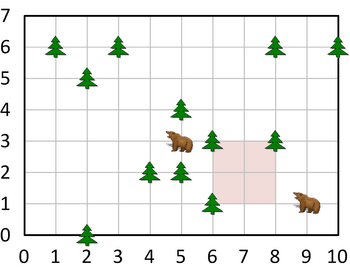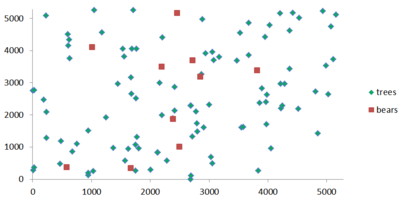Computer Science & Software Engineering
CSCI 135
Fundamentals of Computer Science I
Fall 2011
|
Computer Science & Software Engineering |
CSCI 135 |
10 7 14 1 6 40 20 2 5 32 18 3 6 23 15 4 2 50 24 5 2 18 6 5 3 -1 -1 5 4 80 30 6 1 33 17 6 3 29 17 8 3 75 30 8 6 9 4 9 1 -1 -1 10 6 42 21 2 0 49 20 |
 The pink shaded area is the optimal 4 ft^2 lease. |
Here is a much bigger square mile forest, some example runs, and a graph of the square mile forest:% java LoggingLease 4 < 10x7.txt Forest trees : 12 Forest bear dens : 2 Best southwest : (6, 1) Best northeast : (8, 3) Best tree volume : 158.77176344661575 ft^3 % java LoggingLease 9 < 10x7.txt Forest trees : 12 Forest bear dens : 2 Best southwest : (2, 4) Best northeast : (5, 7) Best tree volume : 161.22920802240924 ft^3 % java LoggingLease 18 < 10x7.txt Forest trees : 12 Forest bear dens : 2 Best southwest : (6, 2) Best northeast : (10, 6) Best tree volume : 176.07474821139263 ft^3 % java LoggingLease 25 < 10x7.txt Forest trees : 12 Forest bear dens : 2 No lease possible! % java LoggingLease 2 < 10x7.txt Forest trees : 12 Forest bear dens : 2 Best southwest : (4, 4) Best northeast : (5, 5) Best tree volume : 128.0389718453977 ft^3
% java LoggingLease 10000 < square_mile.txt Forest trees : 100 Forest bear dens : 10 Best southwest : (2591, 2185) Best northeast : (2691, 2285) Best tree volume : 451.11381707316303 ft^3 % java LoggingLease 100000 < square_mile.txt Forest trees : 100 Forest bear dens : 10 Best southwest : (2375, 1969) Best northeast : (2691, 2285) Best tree volume : 647.2593310955781 ft^3 % java LoggingLease 7767368 < square_mile.txt Forest trees : 100 Forest bear dens : 10 Best southwest : (2494, 0) Best northeast : (5280, 2786) Best tree volume : 2962.083090075347 ft^3 |
 |
Page last updated: August 16, 2012